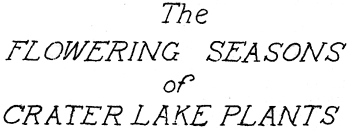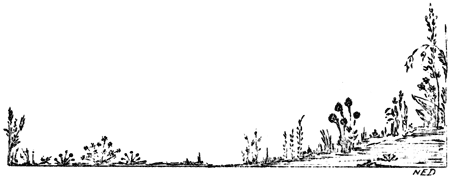|
Volume XI No. 1 - July, 1938
The Flowering Seasons Of Crater Lake Plants
By Elmer I. Applegate, Ranger Naturalist, 1937

Most of the Crater Lake National Park area is occupied by the
truncated cone of Mt. Mazama, the crater of which cups the lake. The
basal altitude is about 4,000 feet, culminating in the higher points of
the crater rim at approximately 8,000 feet. Mt. Scott on the eastern
margin is nearly a thousand feet higher. For a considerable portion of
the year the park is covered by snow. Even at the south entrance, which
reaches the edge of the level valley, not infrequently there are
remnants of snowdrifts until late in May; and not before July is the
ground entirely bare on the south rim. Rarely drifts remain a month
later. Consequently the flowering season is very short. Ususally there
are few, if any, flowers out before the first of June; and the season is
practically over by the middle of September. Beginning at the lower
levels, they continue up the mountain slopes following the retreting
snow. In general there is a gradual replacement by other forms. Some
of the lower forms, more adaptable, find themselves at home on the
higher reaches. These, however, for the most part, ascend the warmer,
more exposed slopes, just as plants of the upper levels tend to drop
down the cold streams and shady sides of canyon walls. Radiating
glacier valleys and stream-cut canyons, wet meadows, bogs, rocky walls,
talus slopes, pumice flats, forest areas -- all these are among the
local contributing factors in distribution and time of flowering.
Within the limits of the park there are upwards of 560 species of
flowering plants. Of these there are perhaps not more than twenty-five
percent which might be considered wild flowers in the more popular sense
of the term. In the present account only these more showy and
attractive forms are included. The first to be considered are those
which are most likely to engage the attention of the average visitor,
such plants are to be seen along the main thoroughfares, improved
trails, about camp grounds and other more frequented places. A second
group includes those found off the beaten paths and in more distant and
inaccessible places, in reach of visitors who have more time and
interest in plant exploration.
The growing time is so brief that it is difficult to draw the line
between seasons. Late spring soon merges into early fall. By the first
of August, normally, before the first flowers are gone, most of the
latest plants are in bloom; thus for a short season nearly all are in
flower at the same time. So in an attempt to list the plants with
reference to their time of blooming, it seems convenient to divide them
into two groups: (A) the earliest or lower level flowers typically
associated with the ponderosa pine, as at the south entrance; and (B)
the later appearing flowers of the uppoer slopes, characteristic of the
hemlock forest area, as for example around Park Headquarters. Between
the hemlock and the ponderosa pine is a more indefinite belt dominated
by lodgepole pine. A similar situation exists in the more open spaces
above the main hemlock belt, extending up to the highest points, such
for exampel as Cloudcap and Llao Rock. This area is typified by the
white-bark pine, a timberline tree of the higher peaks of the Cascades
and other ranges. Much of the moisture is here lost in the loose soil
and by the more rapid evaporation characteristic of high altitudes.
These condistions limit the plants both in number of species and of
individuals. While a few mat plants with well developed root systems
and other adaptive features are peculiar to this windswept area, and a
lesser number of the ponderosa pine association occur here, most of them
are found in the main hemlock region below.
(continued on next page)

|

